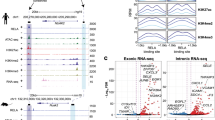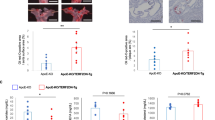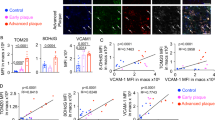Abstract
Hypertension causes endothelial dysfunction, which plays an important role in atherogenesis. The vascular cell adhesion molecule-1 (VCAM-1) contributes to atherosclerotic lesion formation by recruiting leukocytes from blood into tissues. Tumor necrosis factor-α (TNFα) induces endothelial dysfunction and VCAM-1 expression in endothelial cells (ECs). We examined whether the cAMP-response element binding protein (CREB), a transcription factor that mediates cytokine expression and vascular remodeling, is involved in TNFα-induced VCAM-1 expression. TNFα induced phosphorylation of CREB with a peak at 15 min of stimulation in a dose-dependent manner in bovine aortic ECs. Pharmacological inhibition of p38 mitogen-activated protein kinase (p38-MAPK) inhibited TNFα-induced CREB phosphorylation. Adenovirus-mediated overexpression of a dominant-negative form of CREB suppressed TNFα-induced VCAM-1 and c-fos expression. Although activating protein 1 DNA binding activity was attenuated by overexpression of dominant negative CREB, nuclear factor-κB activity was not affected. Our results suggest that the p38-MAPK/CREB pathway plays a critical role in TNFα-induced VCAM-1 expression in vascular endothelial cells. The p38-MAPK/CREB pathway may be a novel therapeutic target for the treatment of atherosclerosis.
Similar content being viewed by others
Article PDF
References
Ross R : The pathogenesis of atherosclerosis: a perspective for the 1990s. Nature 1993; 362: 801–809.
Blann AD, Tse W, Maxwell SJ, Waite MA : Increased levels of the soluble adhesion molecule E-selectin in essential hypertension. J Hypertens 1994; 12: 925–928.
DeSouza CA, Dengel DR, Macko RF, Cox K, Seals DR : Elevated levels of circulating cell adhesion molecules in uncomplicated essential hypertension. Am J Hypertens 1997; 10: 1335–1341.
Parissis JT, Venetsanou KF, Mentzikof DG, et al: Plasma levels of soluble cellular adhesion molecules in patients with arterial hypertension. Correlations with plasma endothelin-1. Eur J Intern Med 2001; 12: 350–356.
Kohara K, Tabara Y, Yamamoto Y, Igase M, Nakura J, Miki T : Genotype-specific association between circulating soluble cellular adhesion molecules and carotid intima-media thickness in community residents: J-SHIPP study. Shimanami Health Promoting Program. Hypertens Res 2002; 25: 31–39.
Iiyama K, Hajra L, Iiyama M, et al: Patterns of vascular cell adhesion molecule-1 and intercellular adhesion molecule-1 expression in rabbit and mouse atherosclerotic lesions and at sites predisposed to lesion formation. Circ Res 1999; 85: 199–207.
Alon R, Kassner PD, Carr MW, Finger EB, Hemler ME, Springer TA : The integrin VLA-4 supports tethering and rolling in flow on VCAM-1. J Cell Biol 1995; 128: 1243–1253.
Pober JS, Cotran RS : The role of endothelial cells in inflammation. Transplantation 1990; 50: 537–544.
Krasinski K, Spyridopoulos I, Kearney M, Losordo DW : In vivo blockade of tumor necrosis factor-alpha accelerates functional endothelial recovery after balloon angioplasty. Circulation 2001; 104: 1754–1756.
Berk BC, Abe JI, Min W, Surapisitchat J, Yan C : Endothelial atheroprotective and anti-inflammatory mechanisms. Ann N Y Acad Sci 2001; 947: 93–111.
Iademarco MF, McQuillan JJ, Rosen GD, Dean DC : Characterization of the promoter for vascular cell adhesion molecule-1 (VCAM-1). J Biol Chem 1992; 267: 16323–16329.
Shaywitz AJ, Greenberg ME : CREB: a stimulus-induced transcription factor activated by a diverse array of extracellular signals. Annu Rev Biochem 1999; 68: 821–861.
Mayr B, Montminy M : Transcriptional regulation by the phosphorylation-dependent factor CREB. Nat Rev Mol Cell Biol 2001; 2: 599–609.
Sheng M, Thompson MA, Greenberg ME : CREB: a Ca2+-regulated transcription factor phosphorylated by calmodulin-dependent kinases. Science 1991; 252: 1427–1430.
Xing J, Ginty DD, Greenberg ME : Coupling of the RAS-MAPK pathway to gene activation by RSK2, a growth factor-regulated CREB kinase. Science 1996; 273: 959–963.
Sugawara A, Takeuchi K, Uruno A, Kudo M, Sato K, Ito S : Effects of mitogen-activated protein kinase pathway and co-activator CREP-binding protein on peroxisome proliferator-activated receptor-γ-mediated transcription suppression of angiotensin II type 1 receptor gene. Hypertens Res 2003; 26: 623–628.
Tan Y, Rouse J, Zhang A, Cariati S, Cohen P, Comb MJ : FGF and stress regulate CREB and ATF-1 via a pathway involving p38 MAP kinase and MAPKAP kinase-2. EMBO J 1996; 15: 4629–4642.
Du K, Montminy M : CREB is a regulatory target for the protein kinase Akt/PKB. J Biol Chem 1998; 273: 32377–32379.
Baud V, and Karin M : Signal transduction by tumor necrosis factor and its relatives. Trends Cell Biol 2001; 11: 372–377.
Chen G, Goeddel DV : TNF-R1 signaling: a beautiful pathway. Science 2002; 296: 1634–1635.
Tokunou T, Ichiki T, Takeda K, et al: Thrombin induces interleukin-6 expression through the cAMP response element in vascular smooth muscle cells. Arterioscler Thromb Vasc Biol 2001; 21: 1759–1763.
Somers JP, DeLoia JA, Zeleznik AJ : Adenovirus-directed expression of a nonphosphorylatable mutant of CREB (cAMP response element-binding protein) adversely affects the survival, but not the differentiation, of rat granulosa cells. Mol Endocrinol 1999; 13: 1364–1372.
Funakoshi Y, Ichiki T, Ito K, Takeshita A : Induction of interleukin-6 expression by angiotensin II in rat vascular smooth muscle cells. Hypertension 1999; 34: 118–125.
Frantz B, Klatt T, Pang M, et al: The activation state of p38 mitogen-activated protein kinase determines the efficiency of ATP competition for pyridinylimidazole inhibitor binding. Biochemistry 1998; 37: 13846–13853.
Ryder JW, Fahlman R, Wallberg-Henriksson H, Alessi DR, Krook A, Zierath JR : Effect of contraction on mitogen-activated protein kinase signal transduction in skeletal muscle. Involvement of the mitogen- and stress-activated protein kinase 1. J Biol Chem 2000; 275: 1457–1462.
Galan A, Garcia-Bermejo ML, Troyano A, et al: Stimulation of p38 mitogen-activated protein kinase is an early regulatory event for the cadmium-induced apoptosis in human promonocytic cells. J Biol Chem 2000; 275: 11418–11424.
Ahmad M, Theofanidis P, Medford RM : Role of activating protein-1 in the regulation of the vascular cell adhesion molecule-1 gene expression by tumor necrosis factor-alpha. J Biol Chem 1998; 273: 4616–4621.
Chinenov Y, Kerppola TK : Close encounters of many kinds: Fos-Jun interactions that mediate transcription regulatory specificity. Oncogene 2001; 20: 2438–2452.
Stein B, Baldwin AS Jr, Ballard DW, Greene WC, Angel P, Herrlich P : Cross-coupling of the NF-kappa B p65 and Fos/Jun transcription factors produces potentiated biological function. EMBO J 1993; 12: 3879–3891.
Karin M : The regulation of AP-1 activity by mitogen-activated protein kinases. J Biol Chem 1995; 270: 16483–16486.
Ichiki T, Tokunou T, Fukuyama K, Iino N, Masuda S, Takeshita A : Cyclic AMP response element-binding protein mediates reactive oxygen species-induced c-fos expression. Hypertension 2003; 42: 177–183.
Funakoshi Y, Ichiki T, Takeda K, Tokunou T, Iino N, Takeshita A : Critical role of cAMP-response element-binding protein for angiotensin II-induced hypertrophy of vascular smooth muscle cells. J Biol Chem 2002; 277: 18710–18717.
Ichijo H : From receptors to stress-activated MAP kinases. Oncogene 1999; 18: 6087–6093.
Kishore R, Luedemann C, Bord E, Goukassian D, Losordo DW : Tumor necrosis factor-mediated E2F1 suppression in endothelial cells: differential requirement of c-Jun N-terminal kinase and p38 mitogen-activated protein kinase signal transduction pathways. Circ Res 2003; 93: 932–940.
Rousseau S, Houle F, Landry J, Huot J : p38 MAP kinase activation by vascular endothelial growth factor mediates actin reorganization and cell migration in human endothelial cells. Oncogene 1997; 15: 2169–2177.
Matsumoto T, Turesson I, Book M, Gerwins P, Claesson-Welsh L : p38 MAP kinase negatively regulates endothelial cell survival, proliferation, and differentiation in FGF-2-stimulated angiogenesis. J Cell Biol 2002; 156: 149–160.
Hale KK, Trollinger D, Rihanek M, Manthey CL : Differential expression and activation of p38 mitogen-activated protein kinase alpha, beta, gamma, and delta in inflammatory cell lineages. J Immunol 1999; 162: 4246–4252.
Lusis AJ : Atherosclerosis. Nature 2000; 407: 233–241.
Moore KL, Patel KD, Bruehl RE, et al: P-selectin glycoprotein ligand-1 mediates rolling of human neutrophils on P-selectin. J Cell Biol 1995; 128: 661–671.
Dong ZM, Chapman SM, Brown AA, Frenette PS, Hynes RO, Wagner DD : The combined role of P- and E-selectins in atherosclerosis. J Clin Invest 1998; 102: 145–152.
Gurtner GC, Davis V, Li H, McCoy MJ, Sharpe A, Cybulsky MI : Targeted disruption of the murine VCAM1 gene: essential role of VCAM-1 in chorioallantoic fusion and placentation. Genes Dev 1995; 9: 1–14.
Cybulsky MI, Iiyama K, Li H, et al: A major role for VCAM-1, but not ICAM-1, in early atherosclerosis. J Clin Invest 2001; 107: 1255–1262.
Pueyo ME, Gonzalez W, Nicoletti A, Savoie F, Arnal JF, Michel JB : Angiotensin II stimulates endothelial vascular cell adhesion molecule-1 via nuclear factor-kappaB activation induced by intracellular oxidative stress. Arterioscler Thromb Vasc Biol 2000; 20: 645–651.
Costanzo A, Moretti F, Burgio VL, et al: Endothelial activation by angiotensin II through NFkappaB and p38 pathways: involvement of NFkappaB-inducible kinase (NIK), free oxygen radicals, and selective inhibition by aspirin. J Cell Physiol 2003; 195: 402–410.
Yoshimoto T, Gochou N, Fukai N, Sugiyama T, Shichiri M, Hirata Y : Adrenomedullin inhibits angiotensin II-induced oxidative stress and gene expression in rat endothelial cells. Hypertens Res 2005; 28: 165–172.
Ju H, Behm DJ, Nerurkar S, et al: p38 MAPK inhibitors ameliorate target organ damage in hypertension: Part 1. p38 MAPK-dependent endothelial dysfunction and hypertension. J Pharmacol Exp Ther 2003; 307: 932–938.
Xu Q, Liu Y, Gorospe M, Udelsman R, Holbrook J : Acute hypertension activates mitogen-activated protein kinases in arterial wall. J Clin Invest 1996; 97: 508–514.
Imai G, Satoh T, Kumai T, et al: Hypertension accelerates diabetic nephropathy in Wistar fatty rats, a model of type 2 diabetes mellitus, via mitogen-activated protein kinase cascades and transforming growth factor-beta1. Hypertens Res 2003; 26: 339–347.
Author information
Authors and Affiliations
Corresponding author
Rights and permissions
About this article
Cite this article
Ono, H., Ichiki, T., Ohtsubo, H. et al. cAMP-Response Element-Binding Protein Mediates Tumor Necrosis Factor-α-Induced Vascular Cell Adhesion Molecule-1 Expression in Endothelial Cells. Hypertens Res 29, 39–47 (2006). https://doi.org/10.1291/hypres.29.39
Received:
Accepted:
Issue date:
DOI: https://doi.org/10.1291/hypres.29.39
Keywords
This article is cited by
-
The cyclic AMP response element‐binding protein (CREB) mediates smooth muscle cell proliferation in response to angiotensin II
Journal of Cell Communication and Signaling (2014)



